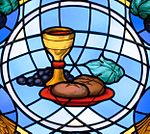Consubstantiation: Difference between revisions
m Bot: Migrating langlinks to WP:Wikidata - d:q1569557 |
DavidABalch (talk | contribs) m →External links: Change broken link to point at the wayback machine. |
||
| Line 21: | Line 21: | ||
==External links== |
==External links== |
||
* [http://www.lcms.org/ca/www/cyclopedia/02/display.asp?t1=C&word=CONSUBSTANTIATION Entry on "Consubstantiation" in the Christian Cyclopedia] |
* [http://web.archive.org/web/20041109230057/http://www.lcms.org/ca/www/cyclopedia/02/display.asp?t1=C&word=CONSUBSTANTIATION Entry on "Consubstantiation" in the Christian Cyclopedia] |
||
[[Category:Lutheran Eucharistic theology]] |
[[Category:Lutheran Eucharistic theology]] |
||
Revision as of 17:22, 20 August 2013
| Part of a series on the |
| Eucharist |
|---|
 |
Consubstantiation is a theological doctrine that (like Transubstantiation) attempts to describe the nature of the Christian Eucharist in concrete metaphysical terms. It holds that during the sacrament, the fundamental "substance" of the body and blood of Christ are present alongside the substance of the bread and wine, which remain present. The doctrine of consubstantiation is often held in contrast to the doctrine of transubstantiation. The adjective consubstantial however describes a different theological concept.
The doctrine of consubstantiation is erroneously identified as the eucharistic doctrine of Martin Luther,[1] who defined his doctrine as the sacramental union.[2] While some Lutherans believe in consubstantiation, others reject the concept because it substitutes what they believe to be the biblical doctrine with a philosophical construct and implies, in their view, a natural, local inclusion of the body and blood of Christ in the consecrated bread and wine of the eucharist.[3]
Literary critic Kenneth Burke's dramatism takes this concept and utilizes it in secular rhetorical theory to look at the dialectic of unity and difference within the context of logology.[4]
History and culture
In England in the late 14th century, there was a political and religious movement known as Lollardy. Among much broader goals, the Lollards affirmed a form of consubstantiation—that the Eucharist remained physically bread and wine, while becoming spiritually the body and blood of Christ. Lollardy survived up until the time of the English Reformation.
See also
References
- ^ F.L. Cross, ed., The Oxford Dictionary of the Christian Church, second edition, (Oxford: Oxford University Press, 1974), 340 sub loco.
- ^ Weimar Ausgabe 26, 442; Luther's Works 37, 299-300.
- ^ J.T. Mueller, Christian Dogmatics: A Handbook of Doctrinal Theology, (St. Louis: CPH, 1934), 519; cf. also Erwin L. Lueker, Christian Cyclopedia, (St. Louis: CPH, 1975), under the entry "consubstantiation."
- ^ http://bradley.bradley.edu/~ell/burke.html
